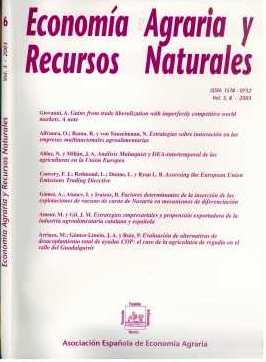Main factors explaining the participation of beef cattle farms from Navarra (Spain) in instruments aimed to products differentiation
Keywords:
Sector vacuno, mecanismos de diferenciación, modelo logit, Indicación Geográfica Protegida.Abstract
Beef cattle sector is readapting to increasing requirements from the demand, which looks for a differentiated product, with constant quality, in a market beginning to be dominated by great distribution companies. Mechanisms to differentiate production are been implemented in this context, co-ordinating both production and marketing processes and integrating livestock farmers into the commercial system. This paper study the relation between these mechanisms and the characteristics of the livestock systems, addressing the causes explaining the voluntary integration of farmers in them. The research area selected was the Comunidad Foral de Navarra due to the existence since more than ten years ago of the Protected Geographic Indication (PGI) «Ternera de Navarra», created to support and promote beef meat from Navarra. In addition to the PGI there also exist differentiation mechanisms represented by small private quality labels implemented by farmers. The development of a Logit model based on a survey to farmers has allowed to identify which are those variables with greater influence in the decision of integration into the PGI. Additionally, results show how this Indication is an important instrument to support some specific livestock systems trough the marketing and promotion of their production. So, the PGI can be considered as a rural development instrument that increased the added value of certain products in less favoured areas, while private labels focus on integrating greater and more intensive farms, more competitive and better adapted to market exigencies.Downloads
Published
2011-10-22
Issue
Section
Articles
License
Assignment of publishing rights for accepted manuscripts: Authors will assign to the Spanish Association of Agricultural Economics (Asociación Española de Economía Agraria, AEEA) the copyright of the manuscript and any supplemental tables, illustrations or other information submitted therewith that are intended for publication as part of or as a supplement to the manuscript in all forms and media (whether now known or hereafter developed), throughout the world, in all languages, for the full term of copyright, effective when and if the article is accepted for publication. No revisions, additional terms or addenda to this Agreement can be accepted without our express written consent.

